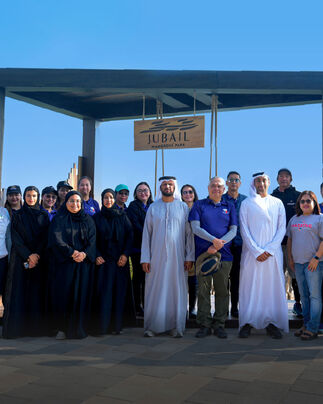Under the directives of His Highness Sheikh Hamdan bin Zayed Al Nahyan, Ruler’s Representative in Al Dhafra Region and Chairman of the Board of Directors of the Environment Agency – Abu Dhabi (EAD), the agency has planted 44 million mangrove trees across Abu Dhabi since 2020 as part of the UAE’s efforts to combat climate change.
EAD, in cooperation with the Department of Municipalities and Transport (DMT) and Abu Dhabi National Oil Company (ADNOC), has successfully planted 23 million mangrove trees within the last two years – equivalent to 9,200 hectares – as part of the Abu Dhabi Mangrove Initiative and efforts to plant 100 million mangrove trees by 2030 to help achieve climate neutrality by 2050.
The initiative, which supports the Abu Dhabi Climate Change Strategy, aimed to expand the scope and speed up the process of preserving and restoring mangrove ecosystems and enhance their important and effective role in combating climate change. These trees are expected to help store approximately 233,000 tonnes of carbon emissions annually, which is equivalent to the energy consumption of more than 25,000 homes.
His Highness Sheikh Hamdan bin Zayed Al Nahyan expressed his happiness with this achievement, which coincides with the UAE’s Year of Sustainability.
His Highness Sheikh Hamdan bin Zayed Al Nahyan said: “The tireless efforts made by Abu Dhabi to plant and preserve mangrove trees are a continuation of the legacy of the late Sheikh Zayed in enhancing and sustaining coastal ecosystems.
“Mangroves are among the most productive coastal ecosystems in the world, and they play a very important role because they provide a variety of environmental and economic services. In addition to the role of mangrove trees in adapting to climate change and reducing its effects, by capturing and storing carbon dioxide from the atmosphere, they are considered one of the essential ecosystems for the life of many marine organisms, including those at risk of extinction.”
His Highness also said that despite the decline in the number of mangroves around the world, and the challenges they face, efforts to plant mangroves in Abu Dhabi continued in a deliberate and consistent manner, out of belief in the power of blue carbon ecosystems and confidence in the ability of nature-based solutions to mitigate and increase resilience to the effects of climate change.
His Highness highlighted that EAD focused its efforts on mangrove restoration as a strategic priority to confront climate change in Abu Dhabi, which was reflected in the recently launched climate change strategy that set ambitious goals to reduce greenhouse gas emissions and confront the risks of climate change.
His Excellency Dr Sultan Ahmed Al Jaber, UAE Minister of Industry and Advanced Technology and UAE Special Envoy for Climate, and Group Managing Director and CEO of ADNOC, said: “We applaud this important achievement that coincides with the Year of Sustainability and confirms our commitment to supporting the UAE’s efforts in protecting the environment and natural habitats by utilising nature-based solutions to reduce the consequences of climate change and enhance biodiversity.
“As part of its ongoing efforts to achieve the goals of the Abu Dhabi Mangrove Initiative, ADNOC, through its cooperation with the Environment Agency – Abu Dhabi, has contributed for more than a decade to supporting the cultivation of mangroves. We will continue to collaborate and work with EAD and other stakeholders and use the latest technologies to enable a more sustainable future.”
Her Excellency Mariam bint Mohammed Almheiri, UAE Minister of Climate Change and Environment, said: “The UAE is expanding mangrove planting as one of the nature-based solutions to confront climate change as they are natural carbon sinks, capable of capturing enormous quantities of carbon, in addition to their benefits in enhancing coastal ecosystems. Abu Dhabi’s success in planting 23 million mangrove trees represents a significant addition to the UAE’s goal of planting 100 million trees by 2030 to help achieve the UAE Net Zero Strategy 2050 and to serve as a committed partner in driving global climate action.”
Her Excellency Dr Sheikha Salem Al Dhaheri, Secretary-General of EAD, said: “In continuation of the late Sheikh Zayed’s legacy, our wise leadership places great value on mangroves as they are a very important coastal ecosystem and a source of blue carbon, and play a key role in carbon sequestration and climate change mitigation. The emirate of Abu Dhabi hosts 85 per cent of the country’s total mangrove forest cover, most of which are located in marine protected areas and near the city. They provide several important environmental services such as eco-tourism activities and are an important shelter for seabirds, many fish and other species, in addition to their important role in purifying the air and marine waters. This is why mangroves are known as the ‘lungs of the city’.”
Mohamed Ali Al Mansoori, Director-General of Al Dhafra Region Municipality, said: “Based on the directives of our wise leadership to make 2023 the Year of Sustainability and coinciding with the United Arab Emirates’ hosting of COP28, the largest international event in the field of climate action, efforts have been intensified to ensure the success of the mangrove planting programme. Many coastal areas and islands were planted, including Al Mirfa city, Al Jalaa, Al Hamra, and Al Shuweihat, as well as Gaga, Rumhan, Al Fazzia, and Al Rafiq islands, to provide the UAE with a more sustainable environment in light of global climate change. Mangrove trees play an important role in protecting coasts from erosion and mitigating the negative impact of strong wave action, in addition to their important role in protecting urban areas and assets located near the coast.”
Mangrove trees in Abu Dhabi are highly flexible in adapting to highly saline environments. Studies conducted by EAD have shown that mangrove trees in Abu Dhabi can store carbon at a rate of 0.5 tonnes per hectare per year, sequestering at least 8,800 tonnes of carbon annually.
Launched in February 2022 by His Highness Sheikh Khalid bin Mohamed bin Zayed Al Nahyan, Crown Prince of Abu Dhabi, and His Royal Highness Prince William, the Prince of Wales, the Abu Dhabi Mangrove Initiative was founded to provide a platform for the development of innovative solutions for planting mangroves, helping Abu Dhabi become a global hub for mangrove research, restoration, and conservation, while acknowledging the importance of technology and innovation in support of biodiversity conservation, in helping communities, and in the fight against climate change.
The Abu Dhabi Mangrove Initiative is an extension of the Blue Carbon Project, focusing on the importance of the mangroves’ carbon sequestration properties. Implemented by EAD, the the initiative secured its first partnership with the Zoological Society in London, through a project conducted with the Jubail Island Investment Company. The initiative aims to act as an umbrella for all research activities and rehabilitation of mangrove sites in the emirate.
Since 2022, at least 12 awareness programmes have been organised under the Abu Dhabi Mangrove Initiative framework, with relevant authorities from government institutions and private sector companies participating. These include mangrove planting on Jubail Island, and several public presentations on the benefits of mangrove condition and conservation. In addition, as part of the initiative, EAD, in cooperation with its partners, is developing an advanced mangrove nursery in Abu Dhabi that aims to become a global hub for research and studies.
Since its launch, the Abu Dhabi Mangrove Initiative has brought together many stakeholders to raise awareness about the need to protect and rehabilitate these important ecosystems, including Jubail Mangrove Park, Etihad Airways, Dawoodi Bohra community, Abu Dhabi Department of Energy (DoE), ADNOC, Swim 62, as well as several embassies in the UAE, and others.









